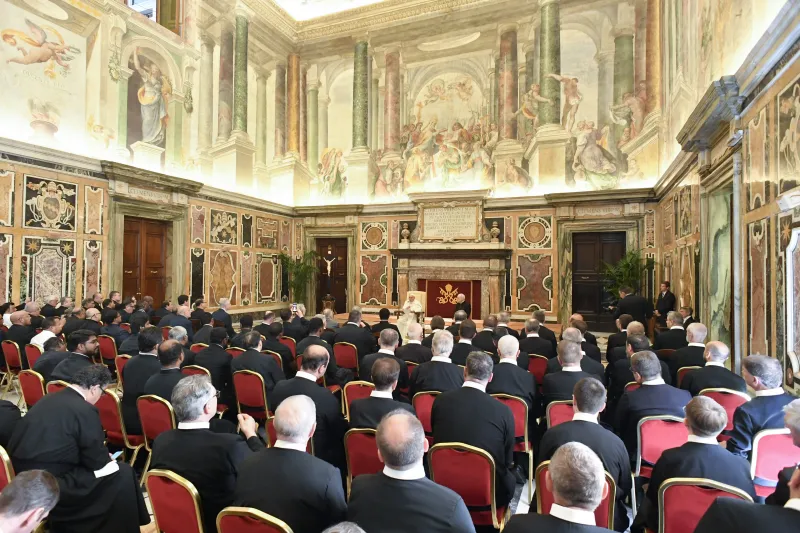
Vatican City, Jul 14, 2022 / 07:39 am (CNA).
In a meeting with three male religious congregations on Thursday, Pope Francis emphasized the importance of taking a “zero tolerance” approach to abuse.
“One of the problems, we know, that often exists, is the problem of abuse. Please, remember this well: zero tolerance on abuse of minors or disabled people, zero tolerance,” he said in the Vatican’s Apostolic Palace July 14.
“Please do not hide this reality,” Francis urged. “We are religious, we are priests to bring people to Jesus, not to ‘consume’ people with our concupiscence.”
He said: “And the abuser destroys, ‘consumes’ so to speak, the abused with his concupiscence. Zero tolerance. Do not be ashamed to denounce, ‘This one did this, that one did that…’”
“I accompany you, you are a sinner, you are a sick person, but I have to protect others,” the pope said, acting out a conversation with an abuser. “Please I ask you this, zero tolerance,” he repeated. “You don’t solve this with a transfer. ‘Ah, from this continent I send him to the other continent…’ No.”
The pope spoke about abuse in an address to members of the Order of the Mother of God, also called Leonardian Fathers; the Congregation of the Mission, also called Vincentians; and the Order of Saint Basil the Great.
The Order of Saint Basil the Great, also known as the Basilian Order of Saint Josaphat, is a Greek Catholic monastic order. It ministers to Ukrainian Catholics and other Greek-Catholic churches in central and eastern Europe.
Pope Francis expressed his closeness and the closeness of the whole Church to the Basilian brothers from Ukraine “in this moment of sorrow, in this moment of martyrdom of your homeland.”
“Many times I think that one of the greatest dangers now is to forget the tragedy of Ukraine,” he said. “One gets used to it,” he lamented. “One of the last days, I saw in the newspaper that the news about the war was on page nine.”
Members of the three congregations were in Rome to participate in their general chapters.
Pope Francis noted at the beginning of his speech that it was a “new mode,” meeting with three different groups of consecrated men at the same time.
“I cherish receiving general chapters, because it is a way of communicating with the consecrated life,” he said. “It is so important in the Church, but there is not always time and, indeed, in this vacation time it is closed, but for you it has been opened.”
If you value the news and views Catholic World Report provides, please consider donating to support our efforts. Your contribution will help us continue to make CWR available to all readers worldwide for free, without a subscription. Thank you for your generosity!
Click here for more information on donating to CWR. Click here to sign up for our newsletter.






A great explicit message about zero tolerance, but then there’s the subliminal, in-your-face, and tolerated messaging of one Archbishop Vincenzo Paglia.
Paglia is now President of the Pontifical Academy for Life and Grand Chancellor of the now Pontifical John Paul II Institute for Studies on Marriage and Family (gutted and renamed the John Paul II Pontifical Theological Institute for Marriage and Family Sciences.
All zero-tolerances are equal, but some are more equal than others…This from Paglia’s cathedral church of the Diocese of Terni-Narni-Amelia: https://www.lifesitenews.com/news/leading-vatican-archbishop-featured-in-homoerotic-painting-he-commissioned
“Zero tolerance,” like he did as archbishop in Buenos Aires, when he protected pederast priests and mocked and deceived the families of sexual abuse victims?
Some may ask, is that so?
Who appointed Cupich cardinal, who refused Marx resignation? Who reinstated Zanchetta? Papa?
Psalm 82:3 Give justice to the weak and the fatherless; maintain the right of the afflicted and the destitute.
Psalm 72:4 May he defend the cause of the poor of the people, give deliverance to the children of the needy, and crush the oppressor!
Isaiah 1:17 Learn to do good; seek justice, correct oppression; bring justice to the fatherless, plead the widow’s cause.